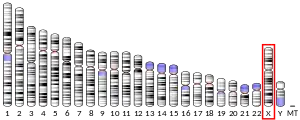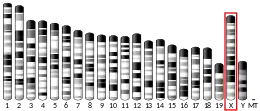Immunoglobulin-binding protein 1 is a protein that in humans is encoded by the IGBP1 gene.[5][6]
Function
The proliferation and differentiation of B cells is dependent upon a B-cell antigen receptor (BCR) complex. Binding of antigens to specific B-cell receptors results in a tyrosine phosphorylation reaction through the BCR complex and leads to multiple signal transduction pathways.[6]
Interactions
IGBP1 has been shown to interact with PPP4C,[7][8][9] PPP6C[8][9] and PPP2CA.[8][9][10][11]
References
- 1 2 3 GRCh38: Ensembl release 89: ENSG00000089289 - Ensembl, May 2017
- 1 2 3 GRCm38: Ensembl release 89: ENSMUSG00000031221 - Ensembl, May 2017
- ↑ "Human PubMed Reference:". National Center for Biotechnology Information, U.S. National Library of Medicine.
- ↑ "Mouse PubMed Reference:". National Center for Biotechnology Information, U.S. National Library of Medicine.
- ↑ Onda M, Inui S, Maeda K, Suzuki M, Takahashi E, Sakaguchi N (Dec 1997). "Expression and chromosomal localization of the human alpha 4/IGBP1 gene, the structure of which is closely related to the yeast TAP42 protein of the rapamycin-sensitive signal transduction pathway". Genomics. 46 (3): 373–8. doi:10.1006/geno.1997.5048. PMID 9441740.
- 1 2 "Entrez Gene: IGBP1 immunoglobulin (CD79A) binding protein 1".
- ↑ Chen GI, Tisayakorn S, Jorgensen C, D'Ambrosio LM, Goudreault M, Gingras AC (Oct 2008). "PP4R4/KIAA1622 forms a novel stable cytosolic complex with phosphoprotein phosphatase 4". The Journal of Biological Chemistry. 283 (43): 29273–84. doi:10.1074/jbc.M803443200. PMC 2662017. PMID 18715871.
- 1 2 3 Gingras AC, Caballero M, Zarske M, Sanchez A, Hazbun TR, Fields S, Sonenberg N, Hafen E, Raught B, Aebersold R (Nov 2005). "A novel, evolutionarily conserved protein phosphatase complex involved in cisplatin sensitivity". Molecular & Cellular Proteomics. 4 (11): 1725–40. doi:10.1074/mcp.M500231-MCP200. PMID 16085932. S2CID 7531012.
- 1 2 3 Chen J, Peterson RT, Schreiber SL (Jun 1998). "Alpha 4 associates with protein phosphatases 2A, 4, and 6". Biochemical and Biophysical Research Communications. 247 (3): 827–32. doi:10.1006/bbrc.1998.8792. PMID 9647778.
- ↑ Goudreault M, D'Ambrosio LM, Kean MJ, Mullin MJ, Larsen BG, Sanchez A, Chaudhry S, Chen GI, Sicheri F, Nesvizhskii AI, Aebersold R, Raught B, Gingras AC (Jan 2009). "A PP2A phosphatase high density interaction network identifies a novel striatin-interacting phosphatase and kinase complex linked to the cerebral cavernous malformation 3 (CCM3) protein". Molecular & Cellular Proteomics. 8 (1): 157–71. doi:10.1074/mcp.M800266-MCP200. PMC 2621004. PMID 18782753.
- ↑ Chung H, Nairn AC, Murata K, Brautigan DL (Aug 1999). "Mutation of Tyr307 and Leu309 in the protein phosphatase 2A catalytic subunit favors association with the alpha 4 subunit which promotes dephosphorylation of elongation factor-2". Biochemistry. 38 (32): 10371–6. doi:10.1021/bi990902g. PMID 10441131.
Further reading
- Chen J, Peterson RT, Schreiber SL (Jun 1998). "Alpha 4 associates with protein phosphatases 2A, 4, and 6". Biochemical and Biophysical Research Communications. 247 (3): 827–32. doi:10.1006/bbrc.1998.8792. PMID 9647778.
- Chung H, Nairn AC, Murata K, Brautigan DL (Aug 1999). "Mutation of Tyr307 and Leu309 in the protein phosphatase 2A catalytic subunit favors association with the alpha 4 subunit which promotes dephosphorylation of elongation factor-2". Biochemistry. 38 (32): 10371–6. doi:10.1021/bi990902g. PMID 10441131.
- Scanlan MJ, Gordan JD, Williamson B, Stockert E, Bander NH, Jongeneel V, Gure AO, Jäger D, Jäger E, Knuth A, Chen YT, Old LJ (Nov 1999). "Antigens recognized by autologous antibody in patients with renal-cell carcinoma". International Journal of Cancer. 83 (4): 456–64. doi:10.1002/(SICI)1097-0215(19991112)83:4<456::AID-IJC4>3.0.CO;2-5. PMID 10508479.
- Liu J, Prickett TD, Elliott E, Meroni G, Brautigan DL (Jun 2001). "Phosphorylation and microtubule association of the Opitz syndrome protein mid-1 is regulated by protein phosphatase 2A via binding to the regulatory subunit alpha 4". Proceedings of the National Academy of Sciences of the United States of America. 98 (12): 6650–5. Bibcode:2001PNAS...98.6650L. doi:10.1073/pnas.111154698. PMC 34408. PMID 11371618.
- Short KM, Hopwood B, Yi Z, Cox TC (2002). "MID1 and MID2 homo- and heterodimerise to tether the rapamycin-sensitive PP2A regulatory subunit, alpha 4, to microtubules: implications for the clinical variability of X-linked Opitz GBBB syndrome and other developmental disorders". BMC Cell Biology. 3: 1. doi:10.1186/1471-2121-3-1. PMC 64779. PMID 11806752.
- Graham JM, Wheeler P, Tackels-Horne D, Lin AE, Hall BD, May M, Short KM, Schwartz CE, Cox TC (Nov 2003). "A new X-linked syndrome with agenesis of the corpus callosum, mental retardation, coloboma, micrognathia, and a mutation in the Alpha 4 gene at Xq13". American Journal of Medical Genetics Part A. 123A (1): 37–44. doi:10.1002/ajmg.a.20504. PMID 14556245. S2CID 26545089.
- Smetana JH, Oliveira CL, Jablonka W, Aguiar Pertinhez T, Carneiro FR, Montero-Lomeli M, Torriani I, Zanchin NI (Apr 2006). "Low resolution structure of the human alpha4 protein (IgBP1) and studies on the stability of alpha4 and of its yeast ortholog Tap42". Biochimica et Biophysica Acta (BBA) - Proteins and Proteomics. 1764 (4): 724–34. doi:10.1016/j.bbapap.2006.01.018. PMID 16517231.
This article is issued from Wikipedia. The text is licensed under Creative Commons - Attribution - Sharealike. Additional terms may apply for the media files.



